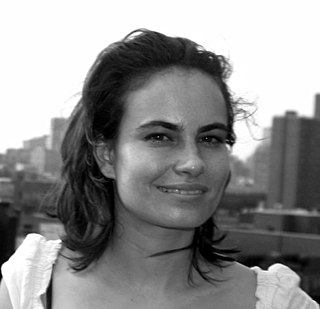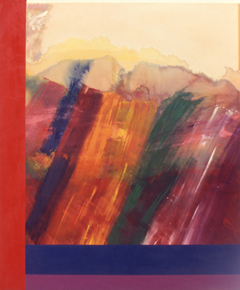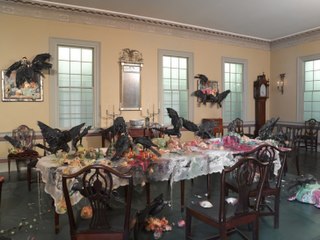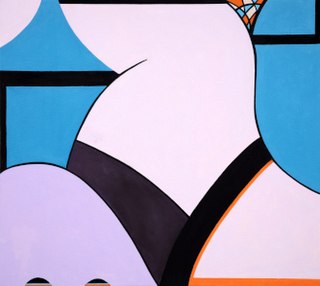
Paul Jackson Pollock was an American painter. A major figure in the abstract expressionist movement, Pollock was widely noticed for his "drip technique" of pouring or splashing liquid household paint onto a horizontal surface, enabling him to view and paint his canvases from all angles. It was called all-over painting and action painting, since he covered the entire canvas and used the force of his whole body to paint, often in a frenetic dancing style. This extreme form of abstraction divided critics: some praised the immediacy of the creation, while others derided the random effects.

Lenore "Lee" Krasner was an American painter and visual artist active primarily in New York whose work has been associated with the Abstract Expressionist movement. She received her early academic training at the Women's Art School of Cooper Union, and the National Academy of Design from 1928 to 1932. Krasner's exposure to Post-Impressionism at the newly opened Museum of Modern Art in 1929 led to a sustained interest in modern art. In 1937, she enrolled in classes taught by Hans Hofmann, which led her to integrate influences of Cubism into her paintings. During the Great Depression, Krasner joined the Works Progress Administration's Federal Art Project, transitioning to war propaganda artworks during the War Services era.

Inka Essenhigh is an American painter based in New York City. Throughout her career, Essenhigh has had solo exhibitions at galleries such as Deitch Projects, Mary Boone Gallery, 303 Gallery, Stefan Stux Gallery, and Jacob Lewis Gallery in New York, Kotaro Nukaga, Tomio Koyama Gallery in Tokyo, and Il Capricorno in Venice.

Ronnie Landfield is an American abstract painter. During his early career from the mid-1960s through the 1970s his paintings were associated with Lyrical Abstraction, and he was represented by the David Whitney Gallery and the André Emmerich Gallery.

Lane Jay Twitchell is a mixed media artist of visionary images. His intricately patterned abstract and semi-representational mixed media works are unmistakable. Twitchell mainly works in paint media, paper cutting, and collage. Cherie K. Woodworth wrote, “What Twitchell does is reinterpret the Western landscape— landscape as kaleidoscope, as a quilt made of paper, as a wide open world refracted in a giant, man-made snowflake. It is the landscape and the heart of the West—its natural grandeur, its history, its modern-day suburbs. Twitchell’s landscape is a labyrinthine desert rose blossoming in the midst of Manhattan.”

Norm Magnusson is a New York-based artist and political activist and founder, in 1991, of the art movement funism; he began his career creating allegorical animal paintings with pointed social commentaries. Eventually became more and more interested in political art and its potential for persuasion.
Mark Dean Veca is an American artist based in Altadena, California. He creates paintings, drawings and large-scale installations.
Sebastiaan Bremer is a Dutch artist who lives and works in New York City.

Ellen Harvey is an American-British conceptual artist known for her painting-based practice and site-specific works in installation, video, engraved mirrors, mosaic and glass. She frequently pairs traditional representational vocabularies and genres with seemingly antithetical postmodern strategies, such as institutional critique, appropriation, mapping and pastiche. Her work examines such themes as art as a mirror, interactions between built environment and landscape, ruins and the Picturesque aesthetic, and cultural and economic relationships between museums, artists and publics. Curator Henriette Huldisch writes of her work, "haunted as it is by the notion of art's ultimate futility, her paradoxical stake is in persistently testing art's possibility to do something in the world after all."
Karin Davie is a contemporary artist who lives and works in New York City and Seattle, Washington.

Valerie Hegarty is an American painter, sculptor, and installation artist. She is known for irreverent, often critical works that replicate canonical paintings, furnishings, and architectural spaces from American or personal history undergoing various processes of transformation. Hegarty most often portrays her recreations in meticulously realized, trompe l’oeil states of decay, ruin, or physical attack related to their circumstances. Her work examines American historical themes involving colonization, slavery, Manifest Destiny, nationalism, art-historical movements and their ideological tenets, romantic conceptions of nature, and environmental degradation. Sculpture critic Robin Reisenfeld wrote that among other things, Hegarty's art is "informed by 19th-century American landscape painting as an expression of the sublime, as well as by the manufacturing of two-dimensional 'masterworks' to be destroyed in three-dimensional fashion in order to evoke entropic forces of growth and decay."

Lisa Corinne Davis is an American visual artist known for abstract paintings and works on paper that suggest maps and other encoded forms of knowledge. She employs abstraction as a means of rendering the complexities of contemporary experience—including her own as an African-American woman—often questioning preconceived notions about identity, classification, and rationality versus subjectivity. Her densely layered, colorful work merges contrasting schemas, visual elements and formal languages, blurring distinctions between figuration and abstraction, real and fictive spaces and concepts, and microcosmic or macrocosmic reference. Brooklyn Rail critic Joan Waltemath wrote, "The urban experiences of space and time that Davis presents are subtle distillations of moment and coincidence ... Her attempt to map the shattered terrain of contemporary life points both to an awareness of other times and a belief in navigating the present one."

The Immaculate Conception with Saint John the Evangelist is an oil painting on canvas of c. 1585 by El Greco, depicting the Virgin of the Immaculate Conception with Saint John the Evangelist.

The Virgin of the Immaculate Conception is a painting of the Immaculate Conception by El Greco. The work on the painting began in 1607 and was completed in 1613. It is owned by the church of San Nicolás de Bari in Toledo, Spain. It is displayed, however, in the Museum of Santa Cruz in Toledo, Spain.
Colette Stuebe Bangert is an American artist and new media artist who has created both computer-generated and traditional artworks. Her computer-generated artworks are the product of a decades-long collaboration with her husband, Charles Jeffries "Jeff" Bangert (1938–2019), a mathematician and computer graphics programmer. Bangert's work in traditional media includes painting, drawing, watercolor and textiles.
Athena LaTocha is an American artist based in New York artist. Her mixed-media works focus on humans' relationships to natural landscapes. She is of Hunkpapa Lakota and Ojibwe descent.

Olive Madora Ayhens, is an American visual artist. She first gained recognition in California in the 1970s for stylized figurative work, but is most known for the fantastical, dizzying cityscapes, landscapes and interiors, often depicting New York City, that she has painted since the mid-1990s. These works intermingle the urban and pastoral, and inside and outside, employing absurd juxtapositions, improbabilities of scale and vibrant colors, in pointed but playful explorations of the clash between civilization and nature. New York Sun critic David Cohen has described her images as "poised between the lyrical and the apocalyptic. They capture both the poetry and the politics of the densely populated, literally and metaphorically stratified, used and abused city." She is based in Brooklyn, New York.

Charlotte Schulz is an American visual artist best known for intricate charcoal drawings, sometimes composed of multiple sheets that she tears, folds and distresses in order to disrupt the two-dimensional picture plane. Her work explores personal and collective responses to traumatic, often-public, experiences and events, interweaving vignettes of landscape, interiors, disasters and unexpected elements in dreamlike combinations that upend spatial and temporal conventions. Artillery critic Seph Rodney describes her drawings as works of "elegant and surreal lyricism" that are exquisitely rendered, thick with detail, and perplexing in their mix of fractured visual logic, overlapping realities, and speculative ruminations on space and time.

Amanda Church is an American artist known for abstract paintings that reference the human figure and other discernible elements. Her works straddle representational and formalist art traditions, suggesting recognizable body parts, objects, and perspectival elements in an otherwise abstract field. Church's distinctive use of contrasting style elements has been consistently noted by critics such as Hyperallergic's Cora Fisher, who described Church's work as "whimsically overruling the left-right brain dichotomy as well as the traditionally gendered axis that divides geometric and decorative art." Church received a Guggenheim Fellowship in 2015 and a Pollock-Krasner Foundation grant in 2017, among other awards. Her work has been covered in publications such as The New York Times, The Boston Globe, ARTnews, Hyperallergic and Forbes Magazine. Her paintings have been exhibited in major U.S. cities as well as internationally, in galleries and museums such as the Brooklyn Museum of Art and the Aldrich Museum. She lives and works in New York.

Hilary Wilder is an American visual artist and educator based in Richmond, Virginia. She is primarily known for painting and installation art, but has also worked in sculpture and video. Her art employs wide-ranging, familiar visual languages—for example, from landscape and abstract painting and modern design—to explore how personal experience, historical events and places are represented, and sometimes fictionalized, misunderstood or idealized.














